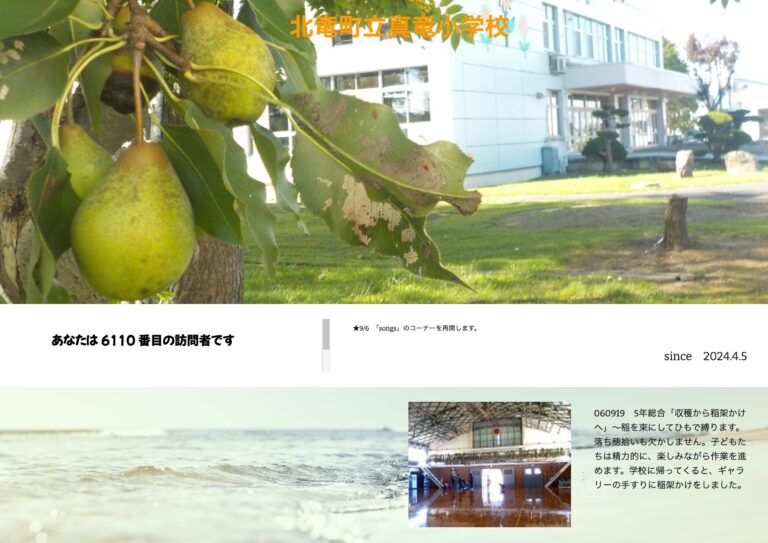Friday, November 22, 2024
On Wednesday, November 20th, nine fifth graders at Kitaryū Town Shinryu Elementary School participated in a home economics class as part of their comprehensive studies, where they practiced making rice balls and miso soup.
- 1 Harvest Festival: Making rice balls and miso soup
- 2 Enjoy the delicious rice balls and miso soup!!!
- 3 Agricultural Newspaper Production
- 4 Mayu Elementary School Website (Photo and article by Sadao Kamata, Principal)
- 5 Youtube Video
- 6 More Photos
- 7 Related Articles
Harvest Festival: Making rice balls and miso soup



The rice used for the onigiri is newly harvested rice, which has been cultivated since May under the guidance of Mr. Akimitsu Takada, and has undergone practical training in planting, harvesting, threshing, etc.
The students cooked the new year's rice and made three types of rice balls (salt, salmon, and plum). The miso soup contained daikon radish, fried tofu, and green onions.
Making rice balls
Wash the rice, add water (1.5 times the weight of the rice) and soak for 30 minutes. Bring to a boil on high heat, then reduce to medium heat, and once the water has evaporated reduce to low heat. Steam for about 10 minutes.

Put half of the freshly cooked, piping hot rice into a bowl, put the ingredients (salmon and plum) in the middle, put another half of the rice on top, and shake the bowl around... Is it round now?
Children who don't use bowls place the rice firmly in their little hands and squeak it into a triangle!!!
The result is a variety of unique rice balls with different shapes and sizes!




Making miso soup
Make a stock using dried sardines (heads and guts removed), cut up daikon radish (cut into chrysanthemum shapes), fried tofu (cut into strips), and green onions (cut into small pieces), and simmer in the stock. Finally, add miso and it's done!

Enjoy the delicious rice balls and miso soup!!!




Agricultural Newspaper Production
The students carefully researched rice from various perspectives and created agricultural newspapers. Each student gave a wonderful and unique research presentation on topics such as the secret of rice's deliciousness, the difficulties and ingenuity of rice cultivation, agricultural machinery, rice storage warehouses, etc.

Three students gave presentations on their research, and then expressed their gratitude and impressions to Mr. Takada for his guidance.
Presentation 1

I investigated the secret behind the deliciousness of Hokuryu Town's rice.
Nutritional value of Hokuryu rice
- As you can see in the photo on the right, rice is packed with nutrients.
- In addition to starch, which is the source of power, rice is rich in nutrients such as protein, fat, vitamin A, and vitamin E.
I went to J.A.
- The machine on the left separates the rice from the good rice and the bad rice by removing the bad colored rice and the rice eaten by insects. This is the bad rice. The bad rice is brown or yellow-green in color.
- This is a warehouse for storing rice. It was cold inside and very spacious.
- Rice is loaded using a machine like the one on the left.
- The machine above is used to break down rice stalks.
Why is rice so delicious in Hokkaido even though it's so cold?
- Hokkaido is much colder than Kyushu and other areas. It's hard to grow rice in the cold. However, Hokkaido rice is so delicious that it is in the top three most delicious rice in Japan.
- Why do you think that is? It's because they made rice that can withstand the cold. Many researchers have made Hokkaido rice resistant to the cold, and it has become delicious.
Conditions for making delicious rice
- The fruit must be beautiful and free from high and low temperatures, disease, and pests.
- Water is abundant
- Wide and flat land
- Large temperature difference between day and night
If these four conditions are met, the rice will be very delicious.
Hokkaido rice is so delicious because it meets all these conditions.
Baby rice and grown rice
- The photo on the left (July 8th) is of a rice baby.
- When it grows, it will look like this on September 4th
- It takes two months for it to reach this size.
Summary and Impressions
- It turns out that thanks to the efforts of researchers, Hokkaido rice has become more delicious.
- They used a machine to remove the bad rice and separate it into good and bad rice.
- There was a warehouse for storing rice. The warehouse was so large that it was impossible to count how much rice could be stored inside. I learned a lot about rice through the rice planting experience.
Presentation 2

The rice from Hokuryu Town is very delicious.
There must be a lot of hard work involved in producing such delicious rice, so we decided to look into the hard parts of rice farming.
The hard part about growing rice
- Tip 1: Adjusting the water
Adjusting water: Rice cultivation is affected by the weather. If it is hot, you need to give the rice cold water to cool it down. Conversely, if it is cold, you need to give it lots of water to keep it warm, which is a big challenge. - Part 2: Harvesting is hard work
Autumn harvest time: Autumn harvest is no good if it is too early, and no good if it is too late. There is a perfect time, but if it rains, we can't harvest the rice, which is a problem. Autumn comes early in Hokkaido, so it seems that the harvest time is difficult. - Number 3: The enemy of weeding
Mowing: Mowing on a hot day is hard work. Mowing keeps insects away and reduces disease. That's why they weed diligently. Good luck, farmers! Don't give in to the heat! - Part 4: Farmers' ingenuity
Raising seedlings: Raising seedlings is hard work. It would be much easier if we didn't have to make seedlings. So, there is a method to sow the rice seeds directly in the rice field so that we don't have to raise seedlings. I admired the farmers who work ingeniously. - Summary: Thoughts
I learned that rice farmers have a lot of hardships. Even with the invention of machines, there are still hardships.
Tools used in the past to grow rice
- The photo on the right shows a Furukawa rotary soil crusher. This tool was used from the early to mid-Showa period to dig up the soil in rice fields.
- They used horses and oxen to break up the soil into small pieces in preparation for planting.
- Now I use a tractor. A tractor is a machine that can do many things, such as applying fertilizer and pesticides and weeding.
editorial postscript
- I experienced rice farming in the old days at school. The first thing I did was plant rice.
- It was still a little cold in May, so it was cold when I got in the water.
- It was hard to walk and it was cold because I was barefoot. Next, we harvested. It was hard at first, but once I got used to it, it was easy and fun. Next, we went to the JA to thresh the rice. I was looking forward to what we would do there.
- When I went to the JA, the first thing I did was thresh rice with a thresher. What surprised me the most was how much rice was stored there. It was so piled up that it looked like it might fall over. I realized that rice farming is as hard work today as it was in the past.
Thanks and thoughts to Takada-san

"I had the opportunity to experience rice farming.
Before this experience, I wasn't that interested in how rice is grown or the secret behind its deliciousness. I didn't know anything about rice, so thanks to Mr. Takada and his team's help, I was able to learn about the deliciousness of rice and everything I wanted to know about rice.
Planting the seedlings was a bit disgusting as my feet got all muddy and there were tree-like things in them which hurt, but it was a lot of fun planting them.
And when it was time to harvest the rice, I enjoyed the feeling of it.
Thank you for giving me so many experiences."
All the students said "Thank you very much!"
Akimitsu Takada's Story

"Thank you for the meal today.
This summer, they had the opportunity to experience growing rice for a year.
Japan is now said to be experiencing global warming.
It is said that the accumulated temperature in Hokkaido has risen by 4 to 5 degrees compared to 40 to 50 years ago.
In the past, it was not possible to harvest such delicious rice even in Hokkaido. However, as the temperature rises, the rice has become more delicious.
Until then, people in Hokkaido had been told that they had to take measures against the cold, but now they have to take measures against the high temperatures.
Just as you have to be careful not to get heatstroke in the summer, crops also need to be careful about the heat.
Don't forget the importance of food.
Please remember what you have learned this year.
thank you very much!".
Finally, we took a commemorative photo with all the students!

We are grateful to Mr. Takada for his guidance and to the delicious rice that grew, and we send our boundless love, gratitude, and prayers to the students of Shinryu Elementary School who learned through this practical experience about the difficulties and hardships of rice cultivation and were able to realize the importance of food through their "rice farming experience."

Mayu Elementary School Website (Photo and article by Sadao Kamata, Principal)
Youtube Video
More Photos
Related Articles
Thursday, November 21, 2024 View this post on Instagram Shared by Akihiko Takada (@qiuguanggaotian)...
Monday, October 7, 2024 Two weeks have passed since the fifth graders of Shinryu Elementary School experienced rice harvesting and hanging as part of their comprehensive learning class.
Friday, September 20, 2024...
Wednesday, May 22, 2024 ◇...
Wednesday, May 22, 2024 View this post on Instagram Takada Akimitsu (@qiuguanggaotian) shared...
Tuesday, May 21, 2024 ◇...
◇ Reporting and writing by Ikuko Terauchi (Photography and editorial assistance by Noboru Terauchi) 
